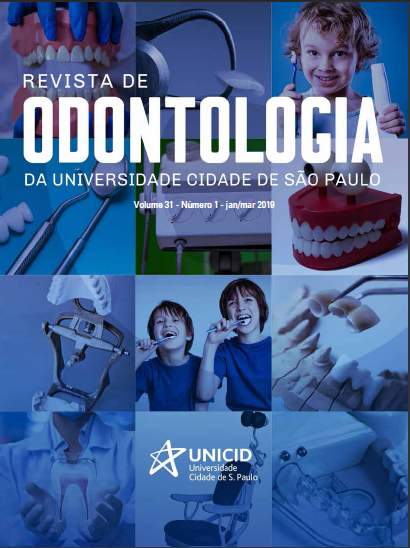Oscillatory joint mobilization as a physiotherapeutic treatment of temporomandibular dysfunction: a case report
DOI:
https://doi.org/10.26843/ro_unicidv3112019p88-94Palavras-chave:
Pain, Temporomandibular joint dysfunction syndrome, PhysiotherapyResumo
Introduction: The temporomandibular joint (TMJ) acts during chew, swallowing, yawning, conversation and in activities involving jaw movements. Temporomandibular Dysfunction (TMD) is a set of disorders involving the masticatory muscles in the TMJ and associated structures. Joint mobilization aims to relief pain and restoring the function of the compromised body segment, increasing its degree of mobility. Objective: We aimed to evaluate the influence of oscillatory joint mobilization on TMD. Method: A descriptive case study with a patient who presented a clinical diagnosis of TMD in the Clinical School of Physiotherapy of the Leão Sampaio School, Juazeiro do Norte, CE, Brazil, from September 3 to October 6 of 2014, twice a week, lasting 40 minutes, a total of 10 visits. Results: The patient presented a gain in the range of motion of the mouth opening (from 17 mm to 46 mm), pain relief (from grade 6 to grade 0 on the Visual Analogue Scale) and improvement in muscle function. Conclusion: Oscillatory joint mobilization in TMD may be effective in increasing mandibular range of motion and opening of the mouth, as well as in reducing TMJ pain and masticatory musculature.
Downloads
Referências
CALIXTRE LB, Moreira RF, Franchini GH, Alburquerque-Sendin F, Oliveira AB. Manual therapy for the management of pain and limited range of motion in subjects with signs and symptoms of temporomandibular disorder: a systematic review of randomised controlled trials. Journal of oral rehabilitation 2015 Nov;42(11):847-61. 2. SILVA GR, Martins PR, Gomes KA, Mambro TRD, Abreu NS. O efeito de técnicas de terapias manuais nas disfunções craniomandibulares. Rev Bras Cien Med Saúde 2011 1(1):17-22. 3. OLIVEIRA AS, Bermudez CC, Souza RA, Souza CMF, Dias EM, Castro CES, et al. Impacto da dor na vida de portadores de disfunção temporomandibular. J Appl Oral Sci 2003 jun.;11(2):138-43. 4. CALIXTRE LB, Grüninger BLS, Haik MN, Alburquerque-Sendín F, Oliveira AB. Effects of cervical mobilization and exercise on pain, movement and function in subjects with temporomandibular disorders: a single group pre-post test. J Appl Oral Sci 2016 jun.;24(3):188-97. 5. CALIXTRE LB, Grüninger BLS, Chaves TC, Oliveira AB. Is there an association between anxiety/depression and temporomandibular disorders in college students? J Appl Oral Sci 2014 Jan-Feb;22(1):15-21. 6. GIL-MARTINEZ A, Grande-Alonso M, Lopez-De-Uralde-Villanueva I, Lopez-Lopez A, Fernandez-Carnero J, La Touche R. Chronic Temporomandibular Disorders: disability, pain intensity and fear of movement. The journal of headache and pain 2016 Dec; 17 (1):103. 7. DE Godoy CH, Silva PF, De Araujo DS, Motta LJ, Biasotto-Gonzalez DA, Politti F, et al. Evaluation of effect of low-level laser therapy on adolescents with temporomandibular disorder: study protocol for a randomized controlled trial. Trials 2013 Jul 22; 14 (229. 8. KRAUS S, Prodoehl J. Outcomes and patient satisfaction following individualized physical therapy treatment for patients diagnosed with temporomandibular disc displacement without reduction with limited opening: A cross-sectional study. Cranio: the journal of craniomandibular practice 2019 Jan;37(1):20-7. 9. KRAUS SL. Characteristics of 511 patients with temporomandibular disorders referred for physical therapy. Oral surgery, oral medicine, oral pathology and oral radiology 2014 Oct;118(4):432-9. 10. KRAUS S, Prodoehl J. Disc displacement without reduction with limited opening: A clinical diagnostic accuracy study. Physiotherapy theory and practice 2017 Mar;33(3): 238-44.

